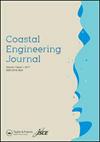理想化沿海工业场地海啸数值模拟模型的验证
IF 1.9
3区 工程技术
Q3 ENGINEERING, CIVIL
引用次数: 3
摘要
海啸数值模型已被提出,但其预测精度尚未得到直接比较。为了量化建模的不确定性,作者对第17届世界地震工程会议海啸盲赛参与者提交的预测结果进行了统计分析。与三维(3D)模型相比,当使用非线性浅水方程模型(NSWE)时,由孤立子裂变海啸产生的近海水位的再现性显著降低。淹没深度在三维模型中得到了很好的再现。然而,在三维模型中,作用在结构上的波浪力和陆地上的速度的再现性低于NSWE模型。对于无法基于静水压力假设计算产生的冲击海啸波压力的情况,NSWE模型的预测精度高于3D模型。在小网格单元尺寸下,两个模型的预测精度都没有提高。NSWE模型无法模拟短波分量和垂直压力分布。因此,需要进一步发展三维模型和光滑粒子流体动力学方法(SPH)。所提出的结果有助于海啸数值模拟工具的未来发展。本文章由计算机程序翻译,如有差异,请以英文原文为准。
Validation of tsunami numerical simulation models for an idealized coastal industrial site
ABSTRACT Numerous tsunami numerical models have been proposed, but their prediction accuracies have not been directly compared. For quantifying the modeling uncertainties, the authors statistically analyzed the prediction results submitted by participants in the tsunami blind contest held at the 17th World Conference on Earthquake Engineering. The reproducibility of offshore water level generated due to the tsunami with soliton fission significantly decreased when the nonlinear shallow water equation models (NSWE) was used compared to three-dimensional (3D) models. The inundation depth was reproduced well in 3D models. However, the reproducibility of wave forces acting on the structure and velocities over land was lower in 3D models than that in NSWE models. For cases where the impulsive tsunami wave pressure generated could not be calculated based on the hydrostatic assumption, the prediction accuracy of the NSWE models was higher than that of the 3D models. The prediction accuracies of both models were not improved at small grid-cell sizes. The NSWE model cannot simulate the short-wave component and vertical pressure distribution. Therefore, further developments in 3D models and smoothed particle hydrodynamics methods (SPH) are needed. The presented results contribute to the future development of tsunami numerical simulation tools.
求助全文
通过发布文献求助,成功后即可免费获取论文全文。
去求助
来源期刊

Coastal Engineering Journal
工程技术-工程:大洋
CiteScore
4.60
自引率
8.30%
发文量
0
审稿时长
7.5 months
期刊介绍:
Coastal Engineering Journal is a peer-reviewed medium for the publication of research achievements and engineering practices in the fields of coastal, harbor and offshore engineering. The CEJ editors welcome original papers and comprehensive reviews on waves and currents, sediment motion and morphodynamics, as well as on structures and facilities. Reports on conceptual developments and predictive methods of environmental processes are also published. Topics also include hard and soft technologies related to coastal zone development, shore protection, and prevention or mitigation of coastal disasters. The journal is intended to cover not only fundamental studies on analytical models, numerical computation and laboratory experiments, but also results of field measurements and case studies of real projects.
 求助内容:
求助内容: 应助结果提醒方式:
应助结果提醒方式:


